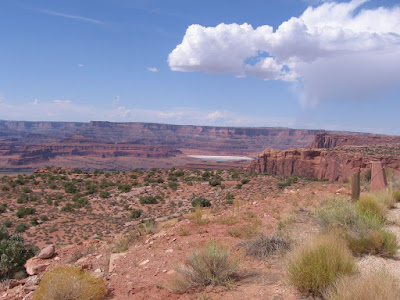 The first view area is about 150 yards up the trail. This view area is to the east of the Island in the Sky District of Canyonlands National Park and Dead Horse Point State Park.
The first view area is about 150 yards up the trail. This view area is to the east of the Island in the Sky District of Canyonlands National Park and Dead Horse Point State Park. The view to the north finds the Colorado River winding through an area where the layers of rock have been bulged upwards, the curving layers obvious. From here there are also views of the potash mining ponds, large blue lagoons sitting among the red rocks.
The view to the north finds the Colorado River winding through an area where the layers of rock have been bulged upwards, the curving layers obvious. From here there are also views of the potash mining ponds, large blue lagoons sitting among the red rocks. Following the rocky loop trail clockwise, the view shifts from the Colorado River canyon to the Kane Creek Canyon. There is a rough looking road down below that crosses the Hurrah Pass from Kane Creek to the Colorado River side. The road isn't as rough as it looks from here. It is possible to easily drive and hike there.
Following the rocky loop trail clockwise, the view shifts from the Colorado River canyon to the Kane Creek Canyon. There is a rough looking road down below that crosses the Hurrah Pass from Kane Creek to the Colorado River side. The road isn't as rough as it looks from here. It is possible to easily drive and hike there.In the extreme distance an arch is visible. My guess is that it is the South Window in Arches National Park.
 Following around and looking southeast the La Sal Mountains loom over more of the Kane Creek Canyon. The overlook trails here are well equipped with guard fences and numerous benches to enjoy the overwhelming views.
Following around and looking southeast the La Sal Mountains loom over more of the Kane Creek Canyon. The overlook trails here are well equipped with guard fences and numerous benches to enjoy the overwhelming views.


 The Wineglass Arch is visible from the road. There are some trail segments, but it is easy just to cross the open field to the base of the rock outcrop.
The Wineglass Arch is visible from the road. There are some trail segments, but it is easy just to cross the open field to the base of the rock outcrop. 











 The trail winds through a pocket surrounded by a large sandstone formation. Water flowing off the rocks and the sheltered position seems to make this a rich area for local plants. The trail guide names 28 different plants at numbered stops.
The trail winds through a pocket surrounded by a large sandstone formation. Water flowing off the rocks and the sheltered position seems to make this a rich area for local plants. The trail guide names 28 different plants at numbered stops.


